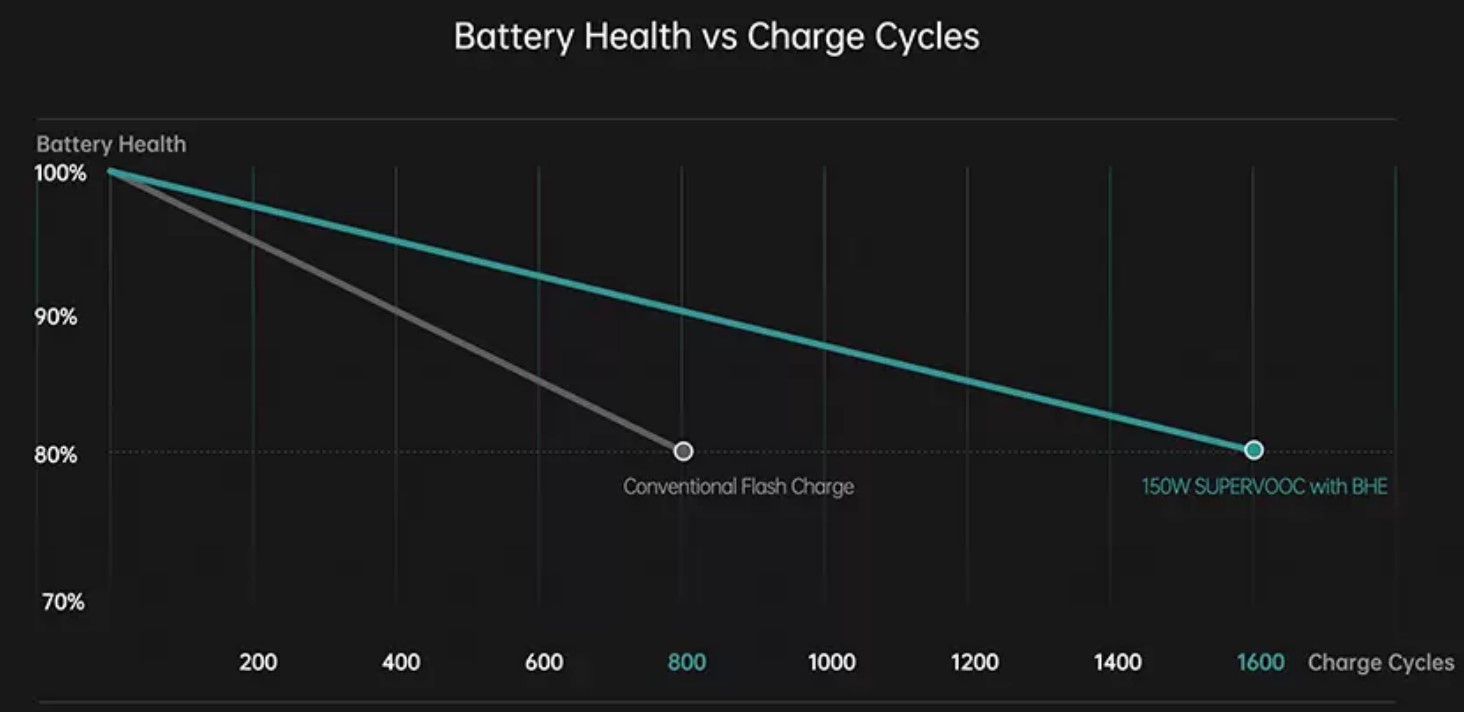The new OPPO 150W and 240W SUPERVOOC will charge a 4500mAh smartphone in 15/9 minutes with no adverse effects on the battery life. That is now at 1600 full charge cycles – two to three times the industry average.
Before the nerds mention the spectre of Samsung Galaxy Note 7 with an inbuilt cigarette lighter, OPPO’s blazing speeds are monitored by its Battery Health Engine (BHE) – a dedicated battery management chip using two OPPO technologies.
Smart Battery Health Algorithm track real-time electric potential across the battery’s negative electrodes. It dynamically adjusts the charging currency within a reasonable range, effectively minimising the occurrence of dead lithium while maintaining the maximum charging current. This helps ensure prolonged battery lifespan and faster-charging speeds.
Battery Healing Technology uses improved electrolyte that continuously repairs the electrodes during charge and discharge cycles. This helps reduce wear and tear of the battery’s positive and negative electrodes, enhancing battery performance and extending battery lifespan.
OPPO 150W and 240W SUPERVOOC
Note that these technologies require compatible phones, chargers and cables. You can still charge with any other USB-C or Qi charger – only not as fast.
150W means 2 x 75W channels to two batteries so that the current remains below 5A.
240W is a new technology that will see three charge channels and batteries, e.g., 3 x 80W channels, again allowing the current to remain below 5W and conform to current USB-C Power Delivery standards.
New 240W phones have five safety protection measures and a specially customised intelligent control chip that controls the voltage, current, temperature and physical damage to deliver a safe charging solution. These phones will have 13 phone temperature sensors, reducing the chance of overheating and avoiding abnormalities.


OPPO 5G CPE T2
This device may not come to Australia due to certification costs. Clearly OPPO sees the need for portable 5G Wi-Fi 6 or WAN gateway to service home and business users.
It uses Qualcomm’s X62 modem-RF system. Better still, it is user-upgradable to later M.2 modem cards like the X65 later this year. It has eight concealed antennas (many portables have only four) and can select the best combination for download speed. Wi-Fi channels are AI monitored to ensure that it does not compete with nearby routers for bandwidth.

Cybershack’s view – OPPO 150W and 240W SUPERVOOC are game-changers
Harking back to the 2016 Samsung Note 7. The fire incidents were unfortunate. They reflected Samsung’s move to a ‘super-fast adaptive charge’ and Qualcomm’s 3A, Quick Charge 2.0. The claim at the time – 50% charge in 30 minutes.
Since then, Samsung has been at the conservative end of charge speeds. It prefers to use 18, 25 and a few 45W chargers (S22+ and ULTRA). Sorry Samsung, but it is unacceptable for a $2,000 phone to take 1.5 hours to charge!
OPPO (and its siblings realme, vivo and OnePlus) use dual batteries and dual charge channels (in VOOC models). Logically this cut charge times by 50% over Samsung and other QC phones and is much gentler on the battery. The only negative is that you have to use an OPPO charger and cable or charge between 10-15W. The fact that other manufacturers have not gone down this path reflects patents and intellectual property.
Now we see real battery innovation with its Battery Health Engine (BHE). It not only gives a full charge in scant minutes but doubles or triples battery cycle life. After 1600 charge/discharge cycles, OPPO still has 80% battery capacity left. Both Apple and Samsung still use 500-800 cycle charge batteries. OPPO has a distinct advantage – over four years full battery life if you charge daily. Even more, if you use AIRVOOC wireless charge to keep it topped up. That is going to help OPPO resale values enormously.



Comments